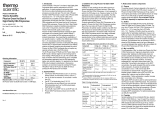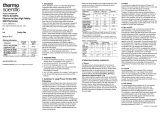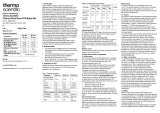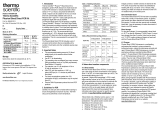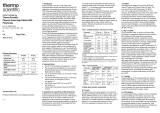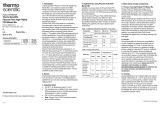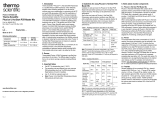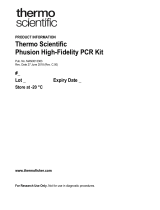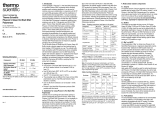Page is loading ...

PRODUCT INFORMATION
Thermo Scientific
Phusion Green Hot Start II High-Fidelity
PCR Master Mix
Pub. No. MAN0016317
Rev. Date 27 June 2018 (Rev. B.00)
#__
Lot __ Expiry Date __
Store at -20 °C
Ordering information
Component
#F-566S
100 rxns
100 x 50 µL rxns
#F-566L
500 rxns
500 x 50 µL rxns
2X Phusion Green Hot
Start II High-Fidelity
PCR Master Mix
2 × 1.25 mL
10 × 1.25 mL
100% DMSO
500 μL
2 × 500 μL
Water, nuclease-free
2 × 1.25 mL
10 × 1.25 mL
www.thermofisher.com
For Research Use Only. Not for use in diagnostic procedures.
__
1.Introduction
Thermo Scientific™ Phusion™ Hot Start II High-Fidelity DNA
Polymerase offers superior performance for all PCR applications.
A unique processivity-enhancing domain makes this Pyrococcus-
like proofreading enzyme extremely processive, accurate and
rapid. The error rate of Phusion Hot Start II DNA Polymerase is
equal to that of Phusion DNA Polymerase (4.4 × 10-7 in Phusion
HF-buffer) when determined with a modified lacI-based method1.
It is approximately 50-fold lower than that of Thermus aquaticus
DNA polymerase and 6-fold lower than that of Pyrococcus
furiosus DNA polymerase. Phusion Hot Start II High-Fidelity DNA
Polymerase is capable of amplifying long amplicons such as the
7.5 kb genomic and 20 kb λ DNA.
Phusion Hot Start II DNA Polymerase combines the DNA
polymerase and a reversibly bound, specific Affibody™ protein2,3,
which inhibits the DNA polymerase activity at ambient
temperatures, thus preventing the amplification of non-specific
products. In addition, the Affibody ligand inhibits the 3’→5’
exonuclease activity of the polymerase, preventing degradation of
primers and template DNA during reaction setup. At
polymerization temperatures, the Affibody molecule is released,
rendering the polymerase fully active. Phusion Hot Start II DNA
Polymerase does not require any separate activation step in the
PCR protocol.
Phusion Hot Start II DNA Polymerase possesses the following
activities: 5’→3’ DNA polymerase activity and 3’→5’ exonuclease
activity. It generates blunt ends in the amplification products.
Phusion Green Hot Start II High-Fidelity Master Mix is a
convenient 2X mix containing Phusion Hot Start II DNA
Polymerase, nucleotides and optimized reaction buffer including
MgCl2. Only template and primers need to be added by the user.
The master mix also includes a density reagent and two tracking
dyes for direct loading of PCR products on a gel. The dyes do not
interfere with PCR performance and are compatible with
downstream applications such as DNA sequencing, ligation and
restriction digestion. For applications that require PCR product
analysis by absorbance or fluorescence excitation, we
recommend using the colorless Phusion Hot Start II High-Fidelity
PCR Master Mix (#F-565S) or purifying the PCR product prior to
analysis.
2. Important Notes
Use 98 °C for denaturation. (See 5.1 & 5.2)
The annealing rules are different from many common DNA
polymerases (such as Taq DNA polymerases). Read Section
5.3 carefully.
Use 15–30 s/kb for extension. Do not exceed 1 min/kb. (See
5.4)
Phusion DNA Polymerases produce blunt end DNA products.
See section 6 for cloning recommendations.
3. Setting up PCR reactions using Phusion Green Hot
Start II High-Fidelity PCR Master Mix
Carefully mix and centrifuge all tubes before opening to ensure
homogeneity and improve recovery. When using Phusion Green
Hot Start II High-Fidelity PCR Master Mix, it is not necessary to
perform the PCR setup on ice.
Due to the unique nature of Phusion DNA Polymerases, optimal
reaction conditions may differ from standard enzyme protocols.
Phusion DNA Polymerases tend to work better at elevated
denaturation and annealing temperatures due to higher salt
concentrations in its buffer. Please pay special attention to the
conditions listed in section 5 when running your reactions.
Following the guidelines will ensure optimal enzyme performance.
Table 1. Pipetting instructions: add items in this order.
Component
20 μL rxn
50 μL rxn
Final conc.
H2O
add to 20 μL
add to 50 μL
2X Phusion
Green HS II HF
Master Mix
10 μL
25 μL
1X
Forward primer *
X μL
X μL
0.5 μM
Reverse primer *
X μL
X μL
0.5 μM
Template DNA
X μL
X μL
(DMSO**,
optional)
(0.6 μL)
(1.5 μL)
(3%)
* The recommendation for final primer concentration is 0.5 μM, but it can be varied in a
range of 0.2–1.0 μM, if needed.
** Addition of DMSO is recommended for GC-rich amplicons. DMSO is not
recommended for amplicons with very low GC % or amplicons that are > 20 kb.
Table 2. Cycling instruction
Cycle step
2-step protocol
3-step protocol
Cycles
Temp.
Time
Temp.
Time
Initial
Denaturation
98 °C
30 s
98 °C
30 s
1
Denaturation
Annealing
(see 5.3)
Extension
(see 5.4)
98 °C
–
72 °C
5–10 s
–
15–30 s/kb
98 °C
X °C
72 °C
5–10 s
10–30 s
15–30 s/kb
25–35
Final
extension
72 °C
4 °C
5–10 min
hold
72 °C
4 °C
5–10 min
hold
1
Poduct Inormation
4. Notes about reaction components
4.1. Phusion Green Hot Start II High-Fidelity PCR Master Mix
Phusion Green Hot Start II High-Fidelity PCR Master Mix contains
all the necessary reaction components except for template DNA
and primers. The master mix provides 1.5 mM MgCl2 and 200 µM
of each dNTP in final reaction concentration. Phusion Hot Start II
DNA polymerase concentration is optimized to give good results
in most reactions. When PCR reaction is set up according to the
instructions, the final concentration of Phusion enzyme is 1 U in
50 μL reaction (0.4 U in 20 μL reaction).
4.2. Template
For low complexity DNA (e.g. plasmid, lambda or BAC DNA) it is
recommended to use 1 pg–10 ng per 50 μL reaction volume. For
high complexity genomic DNA, the amount of DNA template
should be 10–250 ng per 50 μL reaction volume.
If cDNA synthesis reaction mixture is used as a source of
template, the volume of the template should not exceed 10% of
the final PCR reaction volume.
4.3. PCR additives
The recommended reaction conditions for GC-rich templates
include 3% DMSO as a PCR additive, which aids in the
denaturing of templates with high GC contents. For further
optimization, DMSO should be varied in 2% increments. DMSO
may also be required for supercoiled plasmids to relax for
denaturation. If high DMSO concentration is used, the annealing
temperature must be decreased, as DMSO affects the melting
point of the primers. It has been reported that 10% DMSO
decreases the annealing temperature by 5.5–6.0 °C.4
5. Notes about cycling conditions
5.1. Initial denaturation
Denaturation should be performed at 98 °C. Due to the high
thermostability of Phusion DNA Polymerases even higher than
98 °C denaturation temperatures can be used. We recommend
30 seconds initial denaturation at 98 °C for most templates. Some
templates may require longer initial denaturation time and the
length of the initial denaturation time can be extended up to
3 minutes.
5.2. Denaturation
Keep the denaturation as short as possible. Usually
5–10 seconds at 98 °C is enough for most templates. The
denaturation time and temperature may vary depending on the
ramp rate and temperature control mode of the cycler.
5.3. Primer annealing
The optimal annealing temperature for Phusion DNA Polymerases
may be significantly different than annealing temperature with
other DNA polymerases. Always use the Tm calculator and
instructions on our website:
www.thermofisher.com/tmcalculator to determine the Tm
values of your primers and optimal annealing temperature.
If necessary, use a temperature gradient to find the optimal
annealing temperature for each template-primer pair combination.
The annealing gradient should extend up to the extension
temperature (two-step PCR).
Two-step cycling without annealing step is also recommended for
high Tm primer pairs.
5.4. Extension
The extension should be performed at 72 °C. Extension time
depends on amplicon length and complexity. For low complexity
DNA (e.g. plasmid, lambda or BAC DNA) use extension time
15 s per 1 kb. For high complexity genomic DNA 30 s per 1 kb is
recommended.
(continued on reverse page)

6. Cloning recommendations
Blunt end cloning is recommended when cloning DNA fragments
amplified with Phusion DNA Polymerases. If TA cloning is
required, it is necessary to add A overhangs to the PCR product
(with Thermo Scientific Taq DNA Polymerase (#EP0402), for
example). Incubate purified PCR product with 1x Taq buffer,
2.5 mM MgCl2, 0.2 mM dATP and 1 U Taq DNA polymerase in
10 µL reaction mixture up to 30 min at 72 °C. Before adding the
overhangs it is very important to remove all the Phusion DNA
Polymerase by carefully purifying the PCR product, for example
using Thermo Scientific™ GeneJET™ PCR Purification Kit
(#K0701). Any remaining Phusion DNA Polymerase will degrade
the A overhangs, creating blunt ends again.
7. Troubleshooting
No product at all or low yield
Repeat and make sure
that there are no pipetting
errors.
Titrate template amount.
Template DNA may be
damaged. Use carefully
purified template.
Increase extension time.
Increase the number of
cycles.
Optimize annealing
temperature.
Titrate DMSO (2–8%) in the
reaction.
Denaturation temperature
may be too low. Optimal
denaturation temperature
for most templates is
98 °C or higher.
Optimize denaturation time.
Check the purity and
concentration of the
primers.
Check primer design.
Non-specific products - High molecular weight smears
Shorten extension time.
Reduce the total number
of cycles.
Increase annealing
temperature or try 2-step
protocol.
Vary denaturation
temperature
Decrease primer
concentration.
Non-specific products - Low molecular weight discrete
bands
Increase annealing
temperature
Shorten extension time.
Titrate template amount.
Decrease primer
concentration.
Design new primers.
8. References
1. Frey M. & Suppmann B. (1995) Biochemica 2: 34–35.
2. Nord K. et al. (1997) Nature Biotechnol. 15: 772–777.
3. Wikman M. et al. (2004) Protein Eng. Des. Sel. 17:
455–462.
4. Chester N. & Marshak D.R. (1993) Analytical Biochemistry
209: 284–290.
CERTIFICATE OF ANALYSIS
DNA amplification assay
Performance in PCR is tested by the amplification of a 7.5 kb
fragment of genomic DNA.
Quality authorized by: Jurgita Zilinskiene
Important Licensing Information: This product may be covered by one or
more Limited Use Label Licenses. By use of this product, you accept the
terms and conditions of all applicable Limited Use Label Licenses.
PRODUCT USE LIMITATION
This product is developed, designed and sold exclusively for research
purposes and in vitro use only. The product was not tested for use in
diagnostics or for drug development, nor is it suitable for administration to
humans or animals. Please refer to www.thermofisher.com for Material
Safety Data Sheet of the product.
© 2018 Thermo Fisher Scientific, Inc. All rights reserved. All trademarks are
the property of Thermo Fisher Scientific Inc. and its subsidiaries.
/
